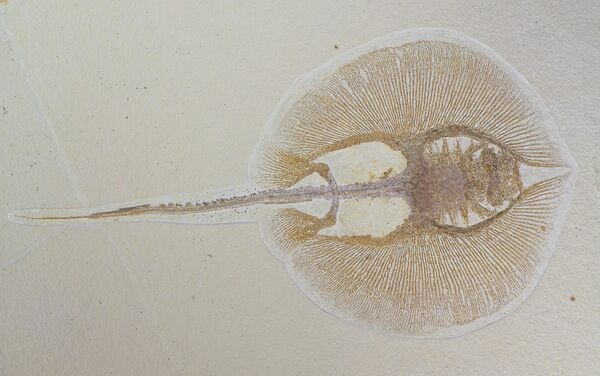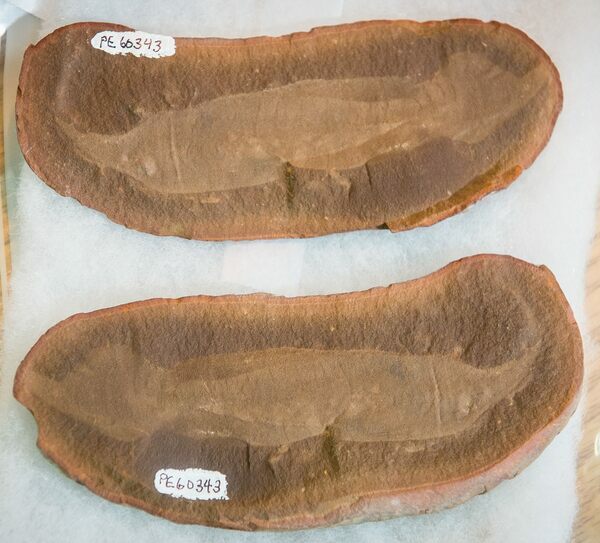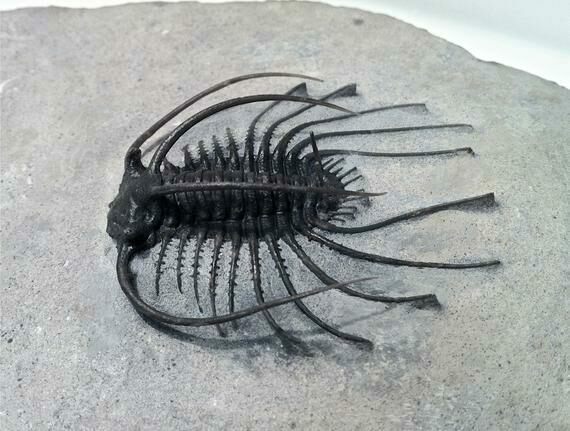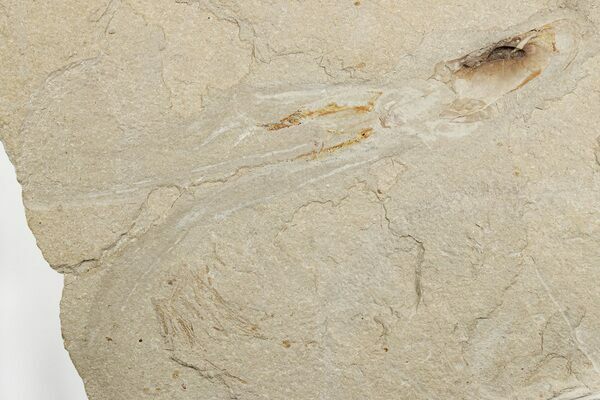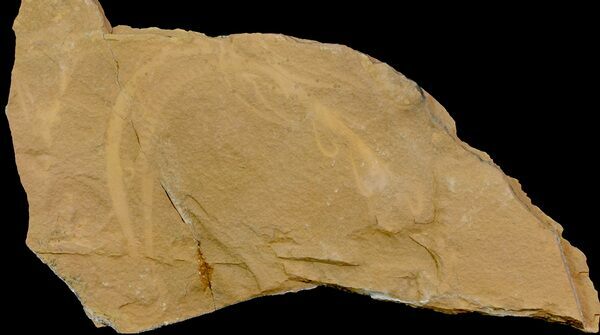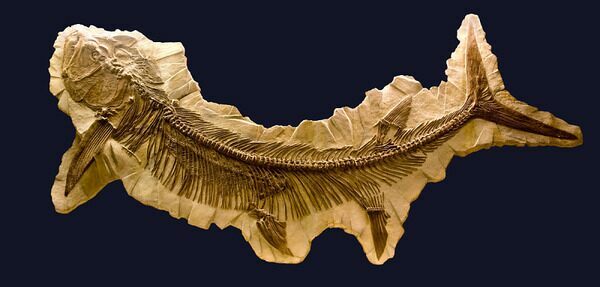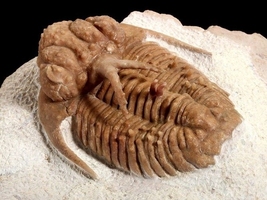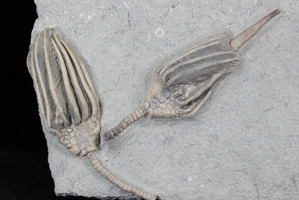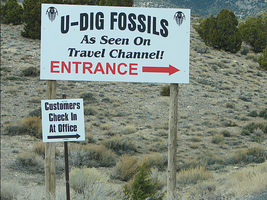Just What Is A Lagerstätte?
I Need A Lagerstätte! And Other Phrases To Excite Both Paleontologists And Alcoholics
A lagerstätte (german for “storage place”) in paleontological terms is a site of exceptional fossilization, in which soft tissue preservation and other highly detailed remains can be retained and recovered. For instance, the famous Burgess Shale, from which many Early Cambrian life forms were discovered and described, is a great example of a lagerstätte. Another example would be the exceptionally well preserved Green River Formation of Wyoming, which shows exceptional preservation of soft tissue in the lives of a variety of organisms of the Eocene epoch; mainly fish, but some exceptional small vertebrates such as lizards, birds, and small mammals as well.
Lagerstätten can form in a variety of ways, mainly dependent on the environment and minerals involved in the fossilization process, and the time period in which it occurred. The majority of lagerstätten form when organic remains end up preserved in a way where oxygen cannot reach it. There are two major forms of lagerstätte preservation, with those being konzentrat-lagerstätten and konservativ-lagerstätten.
konzentrat-lagerstätten are areas of high concentration of fossil remains, places like bone beds where a lot of animals died all at once or repeatedly in roughly the same spot. Such locations are usually imprecise as far as the temporal range they cover, and contain mainly disarticulated remains. However, they also usually contain a high quantity of remains, from a wide variety of organisms, meaning that they are great insights to the general ecology of a region over a long period of time. The La Brea Tar Pits are a great example of a Pleistocene epoch konzentrat-lagerstätte, showing an abundance of large mammalian megafauna fossils across the time period, such as mammoths and giant ground sloths.
On the other end are konservativ-lagerstätten, which preserve incredible detail of both the diversity and abundance of organisms in a relatively precise time frame. Konservativ-lagerstätten preserve soft-bodied, typically hard-to-fossilize organisms like invertebrates with the same detail that they preserve more typically abundant organisms. The Burgess Shale falls into this category, and from it and discoveries like it, much has been learned about the cambrian explosion and the early radiation and adaptation of life.
In general, preservation is best when certain conditions are met shortly after the organism dies. For one thing, the organic remains should be covered quickly by sediment to remove the threat of post-mortem predation. Oxygen also accelerates microbial activity that can distort and damage remains, so preservation in oxygen poor conditions makes for excellent preservation. Lastly, diagenesis, or the process by which the organic material is replaced by minerals, should begin very quickly after death. If all of these conditions are met, it is likely a fossil will form with fantastic preservation. Typically, for a lagerstätte to form like this, there needs to be a fairly fixed part of the environment that lends itself to preservation, like the consistently fine-grained and anoxic mud at the bottom of the lakes that comprise the Green River formation. There are many kinds of preservation, however, and sometimes a lagerstätte can be formed from a rapid dying event, such as a sandstorm or a flood covering a large group of organisms.

A fossilized Triarthrus trilobite from the Beacher's Beds lagerstätte in New York. An anoxic deposition environment allowed for the preservation of soft parts not typically found on trilobite fossils.
The Burgess Shale In British Columbia
This lagerstätte is perhaps one of the most famous and well known. It dates back to the Cambrian period of the Paleozoic era, and contains within it some of the best preservation of the invertebrate fauna of the time. From this 508 million year old shale, discovered in 1909 by paleontologist Charles Wolcott, a number of new and previously undescribed organisms were unearthed. These include the shrimp-like carnivorous radiodonts, and the anomalous organism Hallucigenia, which puzzled scientists for years as to which end was back, front, up or down. It is thought that the high quality preservation was due to anoxic conditions in the seabed clay sediment of the region, as well as the horizontal flow of sediment-bearing seafloor currents.

The most common soft-bodied species in the Walcott Quarry Member of the Burgess Shale Formation is an odd, small arthropod called Marrella splendens. Photo by James St. John
The Green River Formation In Wyoming
This formation, made up of three fossil lakes dating back about 55 million years ago to the Eocene epoch of the Paleogene period, showcases the much milder and even climate of the region at this time. This is evidenced by the presence of crocodilians in the area, as well as subtropical plants such as types of palms. The majority of fossils from the area are very well preserved fishes, with some species of lizard, mammals, birds, and a single snake known. These include the fish genera Knightia, Diplomystus, and Phareodus, all of which are quite ubiquitous in the area. The formation is also known for some of the earliest bats known in the fossil record.
Solnhofen Limestone In Germany
This German lagerstätte dates back to the Jurassic period of the Mesozoic era, during the middle of the age of dinosaurs about 150 million years ago. This is where one of the first and most famous fossil birds was found, Archaeopteryx lithographica, which gave paleontologists new questions and answers regarding the origin of birds. Many large azhdarchid pterosaurs are known from the region, which was an archipelago during the Jurassic period. The formation is also home to a variety of marine organisms as well, such as horseshoe crabs, shrimps like the genus Antrimpos, and lobsters such as Mecochirus. And flitting about in the foliage of these island chains were insects like dragonflies of the genus Stenophlebia. The shallow, ephemeral lagoons that developed and periodically dried up in this oceanic region is likely the reason for the good preservation of both plants and animals alike in the area.
Mazon Creek In Illinois
Mazon Creek dates back to the Carboniferous period, 309 million years ago, when the world had a higher temperature and higher concentration of oxygen than today. The konservativ-lagerstätte, located in Illinois in the United States, can be divided mainly between marine and freshwater fauna, preserved together in what was thought to be an estuarine river delta. The majority of animals found in the creek were invertebrates, with shrimps, crabs, jellyfish, myriapods, worms being some of the most abundant. 42% of the marine biota found in the site is attributable to the jellyfish Essexella. In the freshwater beds, the truly bizarre animal Tullimonstrum (AKA Tully Monster) has been found, which is the state fossil of Illinois.
The Chengjiang biota In China
Part of the Early Cambrian Maotianshan Shales in the Chengjiang biota is the best preserved record of Lower Cambrian life in the world. Over 10 million years old than the famed Burgess Shale in Canada this fauna including possibly over 100 species of soft-bodied animals, many of which their exact classification is still debated. Perhaps the most important fossils from Chengjiang are eight possible members of phylum Chordata, the phylum to which all vertebrates belong. The most famous is Myllokunmingia, possibly a very primitive agnathid (i.e., jawless fish). Similar to Myllokunmingia is Haikouichthys ercaicunensis, another primitive fish-like animal.
Posidonia Shale In Germany
A 180 million year old german locality of Jurassic shale, the Posidonia shale has preserved a large variety of Jurassic period marine fauna. Disarticulated ichthyosaur remains are very common, such as scattered vertebrae, teeth, and other bones. Additionally, belemnites, ammonites, and other invertebrates have been located and identified. Some of these shelled cephalopods show partial pyritization, giving them a uniquely shiny or gold-mottled appearance.
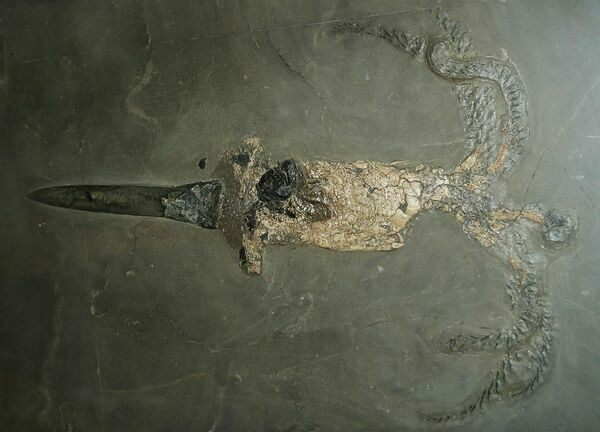
A belemnite fossil from the Posidonia Shale showing soft parts preserved. Photo by Ghedoghedo. Creative Commons License
Bear Gulch Limestone In Montana
Dating back to the Mississippian period of the Carboniferous, about 308 million years ago, Bear Gulch is a Montana lagerstätte which features an abundance of fish, aquatic arthropods, worms, microbial stromatolites, and molluscs. Chondrichthyans make up the majority of fish, and are remarkably diverse, with around 80 different genera attributed to the locale. Arthropods are represented mostly by hoplocarids like Aenigmacaris, a relative of the modern mantis shrimp. Soft-bodied organisms are preserved well in this konservativ-lagerstätte, such as squids and nautiloids.

Echinochimaera meltoni is a fossil holocephalian fish from estuarine deposits of the Late Mississippian-aged Bear Gulch Lagerstätte in Montana. Photo by James St. John
Hunsrück Slate In Germany
The Devonian is colloquially referred to as “the age of fishes”, and this German site, dated to 400-408 million years ago, is a perfect example of this. Many jawless fishes, primitive spiny sharks, and at least one lobe-finned fish have been recovered from the area. The site is also a wealth of invertebrate fossils, and notably, much like Beecher’s Trilobite Bed, there are many invertebrates such as brittle stars and trilobites found with extreme pyrite fossilization, giving them a look like tarnished gold.
Fezouata Formation In Morocco
A Moroccan formation which dates back to the early Ordovician period, 480 million years ago. The fauna here fill a gap in the fossil record for a great many species, including some genera thought to have gone extinct at the end of the Cambrian period. Notable are the trilobites, including the Harpides, Asaphellus and Kierarges genera. Additionally, the unique, filter-feeding giant radiodont Aegirocassis was discovered in this region, and represents possibly the earliest example of macroscopic filter-feeding by a large mobile animal in the fossil record, and possibly the largest animal in the world at the time that Aegirocassis lived.
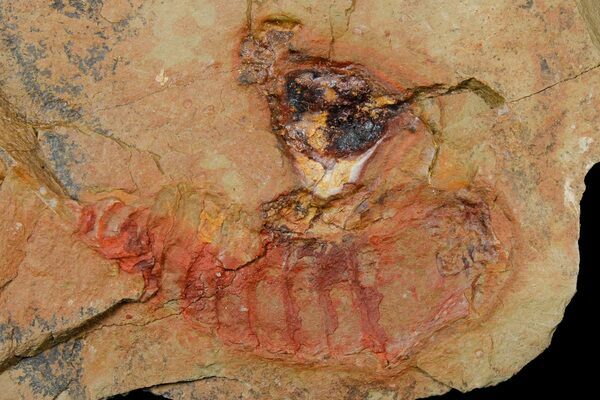
Soft-bodied fossil Aglaspid (Tremaglaspis) from the Fezouata Formation.
Aglaspids are a rare type of arthropod which was probably related to trilobites.
The Walcott-Rust Quarry In New York
Dating back to the Ordovician period of the Paleozoic era, the Walcott-Rust quarry is a wealth of trilobite fossils preserved in exquisite quality. The trilobite genera found here, such as Ceraurus, Flexicalymene, and Isotelus, even show fully fossilized appendages, the first trilobites to be discovered with preserved appendages. In total, there are 18 known trilobite genera found in the quarry, as well as a number of other invertebrates, the most numerous of which outside of trilobites being various echinoderms, such as stalked crinoids.
Hakel/Hjoula/Al-Nammoura In Lebanon
Located in Lebanon, these 100 million year old localities also show an abundance of smaller, soft-bodied marine organisms from the mid Cretaceous period. Astounding preservation has allowed animals like squid and octopodes to endure across the eons, and the preservation of genera like Keuppia and Styletoctopus paints a picture of the transition from ancestral squid-like forms to modern octopodes. Additionally, these fossil beds show a wide variety of vertebrate fossils, such as small marine reptiles, turtles, fishes, and rays.
Wheeler/Marjum/Weeks Formations In Utah
This succession of Middle Cambrian formations located in the House Range and Drum Mountains of Utah, is home to a lagerstätte of trilobites as well as a Burgess Shale-like soft-bodied fauna. Well over a 100 species of trilobites have been described from this mountain range, along with dozens of other marine critters including sponges, early echinoderms, enigmatic arthropods and even delicate jellyfish fossils.
Beecher’s Trilobite Bed in New York
This is another konzentrat-lagerstätte which is, as the name suggests, very trilobite heavy. Charles Emerson Beecher discovered and named the location, but died unexpectedly in 1904, without passing on the exact location of the fossil bed. It was rediscovered in 1984 by Tom E. Whiteley (who also reopened the Walcott-Rust quarry for re-examination in 1990) and Dan Cooper, amateur fossil collectors. It has since been extensively collected by Markus Martin resulting in amazing discoveries of not just trilobites, but several undescribed arthropods preserved in golden pyrite. Dating back to the Late Ordovician, the 445 million year old site is unique for the pyritized nature of the fossils within, giving them a look resembling tarnished gold. It is one of the only fossil sites and lagerstätten in the world to feature this unique form of preservation.
La Brea Tar Pits In California
Located in the urban sprawl of Los Angeles the La Brea Tar Pits offer a unique look into life during the Ice Age from 40,000 to 8,000 years ago.. The tar pits contain possibly the richest, best preserved, and best studied assemblages of Pleistocene vertebrates, including at least 59 species of mammal, over 135 species of bird and over 600 species overall.
Smoky Hill Chalk In Kansas
Part of the larger Niobrara Chalk Formation, the Smoky Hill Chalk lagerstätte dates to the Cretaceous period, over 86 million years ago. Located in Kansas, the site was, at the time, the shore of a wide but receding inland sea, and as such is home to a huge concentration of marine fossils. Reptiles like huge mosasaurs, some flighted pterosaurs, and turtles dominate the majority of faunal remains, and famously, a specimen of the monstrous fish Xiphactinus was once found here with another fish (Gillicus arcuatus) halfway down its throat!
A lagerstätte (german for “storage place”) in paleontological terms is a site of exceptional fossilization, in which soft tissue preservation and other highly detailed remains can be retained and recovered. For instance, the famous Burgess Shale, from which many Early Cambrian life forms were discovered and described, is a great example of a lagerstätte. Another example would be the exceptionally well preserved Green River Formation of Wyoming, which shows exceptional preservation of soft tissue in the lives of a variety of organisms of the Eocene epoch; mainly fish, but some exceptional small vertebrates such as lizards, birds, and small mammals as well.
Lagerstätten can form in a variety of ways, mainly dependent on the environment and minerals involved in the fossilization process, and the time period in which it occurred. The majority of lagerstätten form when organic remains end up preserved in a way where oxygen cannot reach it. There are two major forms of lagerstätte preservation, with those being konzentrat-lagerstätten and konservativ-lagerstätten.
konzentrat-lagerstätten are areas of high concentration of fossil remains, places like bone beds where a lot of animals died all at once or repeatedly in roughly the same spot. Such locations are usually imprecise as far as the temporal range they cover, and contain mainly disarticulated remains. However, they also usually contain a high quantity of remains, from a wide variety of organisms, meaning that they are great insights to the general ecology of a region over a long period of time. The La Brea Tar Pits are a great example of a Pleistocene epoch konzentrat-lagerstätte, showing an abundance of large mammalian megafauna fossils across the time period, such as mammoths and giant ground sloths.
On the other end are konservativ-lagerstätten, which preserve incredible detail of both the diversity and abundance of organisms in a relatively precise time frame. Konservativ-lagerstätten preserve soft-bodied, typically hard-to-fossilize organisms like invertebrates with the same detail that they preserve more typically abundant organisms. The Burgess Shale falls into this category, and from it and discoveries like it, much has been learned about the cambrian explosion and the early radiation and adaptation of life.
Methods Of Preservation
In general, preservation is best when certain conditions are met shortly after the organism dies. For one thing, the organic remains should be covered quickly by sediment to remove the threat of post-mortem predation. Oxygen also accelerates microbial activity that can distort and damage remains, so preservation in oxygen poor conditions makes for excellent preservation. Lastly, diagenesis, or the process by which the organic material is replaced by minerals, should begin very quickly after death. If all of these conditions are met, it is likely a fossil will form with fantastic preservation. Typically, for a lagerstätte to form like this, there needs to be a fairly fixed part of the environment that lends itself to preservation, like the consistently fine-grained and anoxic mud at the bottom of the lakes that comprise the Green River formation. There are many kinds of preservation, however, and sometimes a lagerstätte can be formed from a rapid dying event, such as a sandstorm or a flood covering a large group of organisms.
A fossilized Triarthrus trilobite from the Beacher's Beds lagerstätte in New York. An anoxic deposition environment allowed for the preservation of soft parts not typically found on trilobite fossils.
Lagerstätte Hall Of Fame
The Burgess Shale In British Columbia
This lagerstätte is perhaps one of the most famous and well known. It dates back to the Cambrian period of the Paleozoic era, and contains within it some of the best preservation of the invertebrate fauna of the time. From this 508 million year old shale, discovered in 1909 by paleontologist Charles Wolcott, a number of new and previously undescribed organisms were unearthed. These include the shrimp-like carnivorous radiodonts, and the anomalous organism Hallucigenia, which puzzled scientists for years as to which end was back, front, up or down. It is thought that the high quality preservation was due to anoxic conditions in the seabed clay sediment of the region, as well as the horizontal flow of sediment-bearing seafloor currents.

The most common soft-bodied species in the Walcott Quarry Member of the Burgess Shale Formation is an odd, small arthropod called Marrella splendens. Photo by James St. John
The Green River Formation In Wyoming
This formation, made up of three fossil lakes dating back about 55 million years ago to the Eocene epoch of the Paleogene period, showcases the much milder and even climate of the region at this time. This is evidenced by the presence of crocodilians in the area, as well as subtropical plants such as types of palms. The majority of fossils from the area are very well preserved fishes, with some species of lizard, mammals, birds, and a single snake known. These include the fish genera Knightia, Diplomystus, and Phareodus, all of which are quite ubiquitous in the area. The formation is also known for some of the earliest bats known in the fossil record.
Solnhofen Limestone In Germany
This German lagerstätte dates back to the Jurassic period of the Mesozoic era, during the middle of the age of dinosaurs about 150 million years ago. This is where one of the first and most famous fossil birds was found, Archaeopteryx lithographica, which gave paleontologists new questions and answers regarding the origin of birds. Many large azhdarchid pterosaurs are known from the region, which was an archipelago during the Jurassic period. The formation is also home to a variety of marine organisms as well, such as horseshoe crabs, shrimps like the genus Antrimpos, and lobsters such as Mecochirus. And flitting about in the foliage of these island chains were insects like dragonflies of the genus Stenophlebia. The shallow, ephemeral lagoons that developed and periodically dried up in this oceanic region is likely the reason for the good preservation of both plants and animals alike in the area.
Mazon Creek In Illinois
Mazon Creek dates back to the Carboniferous period, 309 million years ago, when the world had a higher temperature and higher concentration of oxygen than today. The konservativ-lagerstätte, located in Illinois in the United States, can be divided mainly between marine and freshwater fauna, preserved together in what was thought to be an estuarine river delta. The majority of animals found in the creek were invertebrates, with shrimps, crabs, jellyfish, myriapods, worms being some of the most abundant. 42% of the marine biota found in the site is attributable to the jellyfish Essexella. In the freshwater beds, the truly bizarre animal Tullimonstrum (AKA Tully Monster) has been found, which is the state fossil of Illinois.
The Chengjiang biota In China
Part of the Early Cambrian Maotianshan Shales in the Chengjiang biota is the best preserved record of Lower Cambrian life in the world. Over 10 million years old than the famed Burgess Shale in Canada this fauna including possibly over 100 species of soft-bodied animals, many of which their exact classification is still debated. Perhaps the most important fossils from Chengjiang are eight possible members of phylum Chordata, the phylum to which all vertebrates belong. The most famous is Myllokunmingia, possibly a very primitive agnathid (i.e., jawless fish). Similar to Myllokunmingia is Haikouichthys ercaicunensis, another primitive fish-like animal.
Posidonia Shale In Germany
A 180 million year old german locality of Jurassic shale, the Posidonia shale has preserved a large variety of Jurassic period marine fauna. Disarticulated ichthyosaur remains are very common, such as scattered vertebrae, teeth, and other bones. Additionally, belemnites, ammonites, and other invertebrates have been located and identified. Some of these shelled cephalopods show partial pyritization, giving them a uniquely shiny or gold-mottled appearance.
A belemnite fossil from the Posidonia Shale showing soft parts preserved. Photo by Ghedoghedo. Creative Commons License
Bear Gulch Limestone In Montana
Dating back to the Mississippian period of the Carboniferous, about 308 million years ago, Bear Gulch is a Montana lagerstätte which features an abundance of fish, aquatic arthropods, worms, microbial stromatolites, and molluscs. Chondrichthyans make up the majority of fish, and are remarkably diverse, with around 80 different genera attributed to the locale. Arthropods are represented mostly by hoplocarids like Aenigmacaris, a relative of the modern mantis shrimp. Soft-bodied organisms are preserved well in this konservativ-lagerstätte, such as squids and nautiloids.

Echinochimaera meltoni is a fossil holocephalian fish from estuarine deposits of the Late Mississippian-aged Bear Gulch Lagerstätte in Montana. Photo by James St. John
Hunsrück Slate In Germany
The Devonian is colloquially referred to as “the age of fishes”, and this German site, dated to 400-408 million years ago, is a perfect example of this. Many jawless fishes, primitive spiny sharks, and at least one lobe-finned fish have been recovered from the area. The site is also a wealth of invertebrate fossils, and notably, much like Beecher’s Trilobite Bed, there are many invertebrates such as brittle stars and trilobites found with extreme pyrite fossilization, giving them a look like tarnished gold.
Fezouata Formation In Morocco
A Moroccan formation which dates back to the early Ordovician period, 480 million years ago. The fauna here fill a gap in the fossil record for a great many species, including some genera thought to have gone extinct at the end of the Cambrian period. Notable are the trilobites, including the Harpides, Asaphellus and Kierarges genera. Additionally, the unique, filter-feeding giant radiodont Aegirocassis was discovered in this region, and represents possibly the earliest example of macroscopic filter-feeding by a large mobile animal in the fossil record, and possibly the largest animal in the world at the time that Aegirocassis lived.

Soft-bodied fossil Aglaspid (Tremaglaspis) from the Fezouata Formation.
Aglaspids are a rare type of arthropod which was probably related to trilobites.
The Walcott-Rust Quarry In New York
Dating back to the Ordovician period of the Paleozoic era, the Walcott-Rust quarry is a wealth of trilobite fossils preserved in exquisite quality. The trilobite genera found here, such as Ceraurus, Flexicalymene, and Isotelus, even show fully fossilized appendages, the first trilobites to be discovered with preserved appendages. In total, there are 18 known trilobite genera found in the quarry, as well as a number of other invertebrates, the most numerous of which outside of trilobites being various echinoderms, such as stalked crinoids.
Hakel/Hjoula/Al-Nammoura In Lebanon
Located in Lebanon, these 100 million year old localities also show an abundance of smaller, soft-bodied marine organisms from the mid Cretaceous period. Astounding preservation has allowed animals like squid and octopodes to endure across the eons, and the preservation of genera like Keuppia and Styletoctopus paints a picture of the transition from ancestral squid-like forms to modern octopodes. Additionally, these fossil beds show a wide variety of vertebrate fossils, such as small marine reptiles, turtles, fishes, and rays.
Wheeler/Marjum/Weeks Formations In Utah
This succession of Middle Cambrian formations located in the House Range and Drum Mountains of Utah, is home to a lagerstätte of trilobites as well as a Burgess Shale-like soft-bodied fauna. Well over a 100 species of trilobites have been described from this mountain range, along with dozens of other marine critters including sponges, early echinoderms, enigmatic arthropods and even delicate jellyfish fossils.
Beecher’s Trilobite Bed in New York
This is another konzentrat-lagerstätte which is, as the name suggests, very trilobite heavy. Charles Emerson Beecher discovered and named the location, but died unexpectedly in 1904, without passing on the exact location of the fossil bed. It was rediscovered in 1984 by Tom E. Whiteley (who also reopened the Walcott-Rust quarry for re-examination in 1990) and Dan Cooper, amateur fossil collectors. It has since been extensively collected by Markus Martin resulting in amazing discoveries of not just trilobites, but several undescribed arthropods preserved in golden pyrite. Dating back to the Late Ordovician, the 445 million year old site is unique for the pyritized nature of the fossils within, giving them a look resembling tarnished gold. It is one of the only fossil sites and lagerstätten in the world to feature this unique form of preservation.
La Brea Tar Pits In California
Located in the urban sprawl of Los Angeles the La Brea Tar Pits offer a unique look into life during the Ice Age from 40,000 to 8,000 years ago.. The tar pits contain possibly the richest, best preserved, and best studied assemblages of Pleistocene vertebrates, including at least 59 species of mammal, over 135 species of bird and over 600 species overall.
Smoky Hill Chalk In Kansas
Part of the larger Niobrara Chalk Formation, the Smoky Hill Chalk lagerstätte dates to the Cretaceous period, over 86 million years ago. Located in Kansas, the site was, at the time, the shore of a wide but receding inland sea, and as such is home to a huge concentration of marine fossils. Reptiles like huge mosasaurs, some flighted pterosaurs, and turtles dominate the majority of faunal remains, and famously, a specimen of the monstrous fish Xiphactinus was once found here with another fish (Gillicus arcuatus) halfway down its throat!
 Reviews
Reviews
